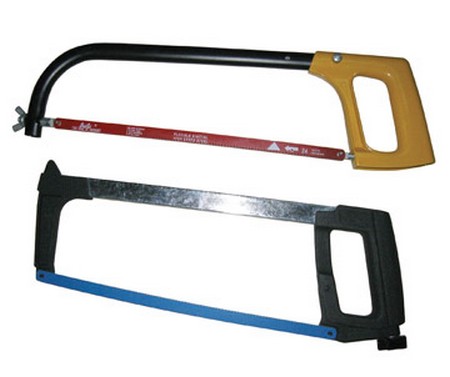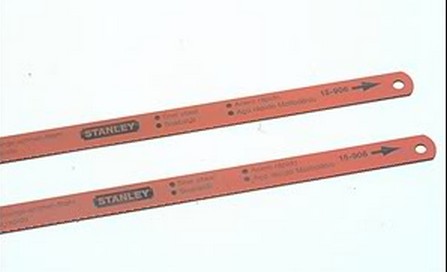Hacksaw blades are usually made from one of two sorts of steel low-alloy steel or high-speed steel. Low-alloy steel blades tend to blunt more quickly than high-speed steel ones.
Blades are normally available in two lengths 250mm and 300mm and with a variety of teeth per inch (called coarseness). Blades with 14, 15, 24 and 32 tpi are commonly available: the coarseness to use depends on the thickness and type of metal being cut. Blades with 18 and 24 tpi are for general use; 32 tpi for cutting sheet metal and thin-walled tubes (copper pipe); and 14 tpi is useful for cutting a soft metal like aluminium because the blade is less likely to become clogged.

The coarseness of the blade usually determines its set. Coarse blades usually have teeth bent each way alternately; fine blades have a wavy set the whole cutting edge of the blade is a wavy shape. The set enables a saw to cut a slot slightly wider than the body of the blade and so reduces the likelihood of the saw jamming.
Hacksaw blades are hardened to make their teeth last longer. Four different types of blade are available.
A flexible blade is hardened only along the row of teeth; the back of the blade is left soft. This allows the blade to spring back if it is bent a little; if it is bent too far, it will not spring back. It may be possible to bend it straight again, but the hardened portion containing the teeth may crack.
An all-hard blade is hardened throughout the blade but has the area around the fixing holes softened to prevent it cracking. This type of blade is very stiff. If it is bent a little, it will spring back; if it is bent too far, it will snap. All-hard blades tend to be used in machines or by professional metalworkers.
A spring-temper blade is heat treated so that it can be bent a long way and still spring back straight rather like a flat spring. Spring-temper blades are not very common.

A bimetal blade is made up of two pieces of metal hence its name. A narrow strip of hard metal with teeth is welded on to a wide softer strip which forms the back.
All-hard blades lend to break fairly easily if the handle of the saw is not lined up exactly with the cut, say. Flexible blades can be bent a long way without breaking, but getting them perfectly straight again can be difficult. Bimetal blades are a compromise between these two extremes and are least likely to be damaged when sawing.